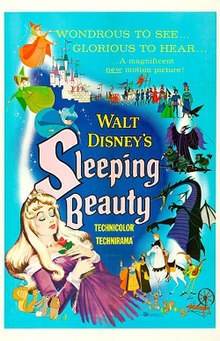
Back الأميرة النائمة Arabic الجميله النائمه (فيلم 1959) ARZ Sleeping Beauty (1959 pelikula) BCL Спящата красавица (филм, 1959) Bulgarian Sleeping Beauty (film, 1959) Breton La Bella Dorment (pel·lícula de 1959) Catalan جوانکیلەی خەوتوو (فیلمی ١٩٥٩) CKB Šípková Růženka (film, 1959) Czech Sleeping Beauty (ffilm 1959) Welsh Tornerose (film fra 1959) Danish
| Sleeping Beauty | |
|---|---|
 Theatrical release poster | |
| Directed by | Supervising director Sequence directors |
| Story by |
|
| Based on | "Sleeping Beauty" by Charles Perrault |
| Produced by | Walt Disney |
| Starring | |
| Edited by |
|
| Music by | George Bruns |
Production company | |
| Distributed by | Buena Vista Film Distribution |
Release date |
|
Running time | 75 minutes |
| Country | United States |
| Language | English |
| Budget | $6 million[1] |
| Box office | $51.6 million (United States and Canada)[2] |
Sleeping Beauty is a 1959 American animated musical fantasy film produced by Walt Disney Productions and released by Buena Vista Film Distribution. Based on Charles Perrault's 1697 fairy tale, the film follows Princess Aurora, who was cursed by the evil fairy Maleficent to die from pricking her finger on the spindle of a spinning wheel on her 16th birthday. She is saved by three good fairies, who alter Aurora's curse so that she falls into a deep sleep and will be awakened by true love's kiss. The production was supervised by Clyde Geronimi, and was directed by Wolfgang Reitherman, Eric Larson, and Les Clark. It features the voices of Mary Costa, Bill Shirley, Eleanor Audley, Verna Felton, Barbara Luddy, Barbara Jo Allen, Taylor Holmes, and Bill Thompson.
Sleeping Beauty began development in 1950. The film took nearly a decade and $6 million (equivalent to $62,712,329 in 2023) to produce, and was Disney's most expensive animated feature at the time. Its tapestry-like art style was devised by Eyvind Earle, who was inspired by pre-Renaissance European art; its score and songs, composed by George Bruns, were based on Pyotr Tchaikovsky's 1889 ballet. Sleeping Beauty was the first animated film to use the Super Technirama 70 widescreen process and was the second full-length animated feature filmed in anamorphic widescreen, following Lady and the Tramp (1955).[3]
It was released in theaters on January 29, 1959, to mixed reviews from critics who praised its art direction and musical score, but criticized its plot and characters. The film was a box-office bomb in its initial release, grossing $5.3 million (equivalent to $55,395,890 in 2023), and losing $900,000 (equivalent to $9,406,849 in 2023) for the distributor. Many employees from the animation studio were laid off. Sleeping Beauty's re-releases have been successful,[4] and it has become one of Disney's most artistically acclaimed features. The film was nominated for the Academy Award for Best Scoring of a Musical Picture at the 32nd Academy Awards.
Maleficent, a live-action reimagining of the film from Maleficent's perspective, was released in 2014, followed by a sequel, Maleficent: Mistress of Evil, in 2019. The latter year, Sleeping Beauty was selected for preservation in the United States Library of Congress' National Film Registry as "culturally, historically, or aesthetically significant".
- ^ Thomas 1994, p. 295.
- ^ "Sleeping Beauty". Box Office Mojo. IMDb. Archived from the original on August 11, 2023. Retrieved January 5, 2012.
- ^ Maltin 1987, p. 74.
- ^ Smith, Dave. ""Sleeping Beauty" Movie History". Disney Archives. Archived from the original on March 31, 2010. Retrieved January 28, 2023.